Effect of Surface Active Agent (SAA) on 50/70 Bitumen Foaming Characteristics
Abstract
:1. Introduction
2. Materials and Research Methodology
2.1. Tested Materials
2.2. Experimental Program
3. Results and Discussion
3.1. The Effects of The SAA Content on basic Bitumen Properties
3.2. Determining Dynamic Viscosity of The Binder with SAA
3.3. Foamed Bitumen Properties
3.4. Optimisation of The SAA Content with Respect to The Standard Bitumen Properties
- softening point (TPiK),
- Fraass breaking point (TFraass),
- penetration index (PI),
- dynamic viscosity at 90 °C (η90) and 135 °C (η135),
- maximum expansion (ER),
- half-life (HL).
- softening point TR&B (max–1, min–0),
- Fraass breaking point TFraass (max–0, min–1),
- penetration index PI (max–1, min–0),
- dynamic viscosity at η90 and η135 (max–0, min–1),
- expansion ratio ER (max–1, min–0),
- half-life HL (max–1, min–0).
4. Conclusions
- the penetration of the bitumen has increased consistently with the increase of the SAA from 65.9 [0.1 mm] of the base bitumen by as much as 4.5 [0.1 mm] in the bitumen with 0.6% SAA content.
- the Fraass breaking has also gradually increased in the function of the SAA content resulting in 1.9 °C change at 0.6% SAA content,
- there were no significant changes in softening point and penetration index associated with the addition of surface active agent,
- the SAA has reduced the bitumen dynamic viscosity in the measured range of temperatures (60 °C, 90 °C, and 135 °C),
- the addition of SAA resulted in profound improvement of foaming characteristics of 50/70 bitumen, showing increased values of half-life (HL), expansion ratio (ER) and foam index (FI) resulting in possible significant contribution of mixture coating and workability,
- the analysis of the desirability function has shown that the addition of surface active agent in 0.6% concentration should result in superior overall performance of the 50/70 penetration binder enhancing the HWA mix quality and workability, without significantly affecting the binder rheology.
Author Contributions
Funding
Acknowledgments
Conflicts of Interest
References
- Stefańczyk, B.; Mieczkowski, P. Mieszanki mineralno-asfaltowe: wykonawstwo i badania. In Bituminous Mixtures. Performance and Research; WKiŁ: Warszawa, Poland, 2008; p. 322. (In Polish) [Google Scholar]
- Piłat, J.; Radziszewski, P. Nawierzchnie asfaltowe: Podręcznik akademicki. In Asphalt Pavements; WKiŁ: Warszawa, Poland, 2010. (In Polish) [Google Scholar]
- Hofko, B.; Dimitrov, M.; Schwab, O.; Weiss, F.; Rechberger, H.; Grothe, H. Technological and environmental performance of temperature-reduced mastic asphalt mixtures. Road Mater. Pavement Des. 2017, 18, 22–37. [Google Scholar] [CrossRef]
- Van De Ven, M.F.C.; Jenkins, K.J.; Voskuilen, J.L.M.; Van Den Beemt, R. Development of (half-) warm foamed bitumen mixes: State of the art. Int. J. Pavement Eng. 2007, 8, 163–175. [Google Scholar] [CrossRef]
- Jenkins, K.J.; De Groot, J.L.A.; Van de Ven, M.F.C.; Molenaar, A. Half-warm Foamed Bitumen Treatment, A New Process”. In Proceedings of the 7th Conference on asphalt pavements for Southern Africa, Victoria Falls, Zimbabwe, 29 August–2 September 1999. [Google Scholar]
- Vaitkus, A.; Čygas, D.; Laurinavičius, A.; Perveneckas, Z. Analysis and evaluation of possibilities for the use of warm mix asphalt in lithuania. Balt. J. Road Bridge Eng. 2009, IV, 80–86. [Google Scholar] [CrossRef]
- Król, J.; Kowalski, K.; Radziszewski, P. Rheological behavior of n-alkane modified bitumen in aspect of Warm Mix Asphalt technology. Constr. Build. Mater. 2015, 93, 703–710. [Google Scholar] [CrossRef]
- Iwański, M.; Mazurek, G. The influence of the low-viscosity modifier on viscoelasticity behavior of the bitumen at high operational temperature. In Proceedings of the 8th International Conference Environmenal Engineering, Vilnius, Lithuania, 19–20 May 2011; Volume 1–3, pp. 1097–1102. [Google Scholar]
- Pszczola, M.; Jaczewski, M.; Rys, D.; Jaskula, P.; Szydlowski, C. Evaluation of asphalt mixture low-temperature performance in bending beam creep test. Materials 2018, 11, 100. [Google Scholar] [CrossRef] [PubMed]
- Hugo Silva, M.R.D.; Joel, R.M.; Oliveira, J.; Peralta, J.; Zooro, S.E. Optimization of warm mix asphalt using different blends of binders and synthetic paraffin wax contents. Constr. Build. Mater. 2010, 24, 1621–1631. [Google Scholar] [CrossRef]
- Leng, Z.; Gamez, A.; Al-Qadi, I.L. Mechanical property characterization of warm-mix asphalt prepared with chemical additives. J. Mater. Civ. Eng. 2014, 26, 304–311. [Google Scholar] [CrossRef]
- Jamshidi, A.; Hamzah, M.O.; You, Z. Performance of Warm Mix Asphalt containing Sasobit®: State-of-the-art”. Constr. Build. Mater. 2013, 38, 530–553. [Google Scholar] [CrossRef]
- Iwański, M.; Mazurek, G. Optimization on the syntetic wax content on example of bitumen 35/50. Procedia Eng. 2013, 57, 414–423. [Google Scholar] [CrossRef]
- Muthen, K.M. Foamed Asphalt Mixes. Mix Design Procedure; Contract Report CR 98/077; SABITA Ltd.&CSIR Transportek: Pretoria, South Africa, 2009. [Google Scholar]
- Wong, W.G.; Li, G. Analysis of the effect of wax content on bitumen under performance grade classification. Constr. Build. Mater. 2009, 23, 2504–2510. [Google Scholar] [CrossRef]
- Sanchez-Alonso, E.; Vega-Zamanillo, A.; Castro-Fresno, D.; Del Rio-Prat, M. Evaluation of compactability and mechanical properties of bituminous mixes with warm additives. Constr. Build. Mater. 2011, 25, 2304–2311. [Google Scholar] [CrossRef]
- Judycki, J.; Stienss, M. Badania mieszanek mineralno-asfaltowych o obniżonej temperaturze otaczania—Raport końcowy. In Evaluation of Low-Temperature Bituminous Mixtures—Final Report; GDDKiA: Warsaw, Poland, 2014. (In Polish) [Google Scholar]
- Lu, X.; Redelius, P. Effect of bitumen wax on asphalt performance. Constr. Build. Mater. 2006, 21, 1961–1970. [Google Scholar] [CrossRef]
- Jenkins, K.J. Mix Design Considerations for Cold and Half-Warm Bituminous Mixes with Emphasis on Foamed Bitumen. Ph.D. Thesis, Department of Civil Engineering, Faculty of Engineering, University of Stellenbosch, Stellebosch, South Africa, 2000. [Google Scholar]
- Chomicz-Kowalska, A.; Gardziejczyk, W.; Iwański, M.M. Moisture resistance and compactability of asphalt concrete produced in half-warm mix asphalt technology with foamed bitumen. Constr. Build. Mater. 2016, 126, 108–118. [Google Scholar] [CrossRef]
- Woszuk, A.; Zofka, A.; Bandura, L.; Franus, A. Effect of zeolite properties on asphalt foaming. Constr. Build. Mater. 2017, 139, 247–255. [Google Scholar] [CrossRef]
- Martinez-Arguelles, G.; Giustozzi, F.; Crispino, M.; Flintsch, G.W. Investigating physical and rheological properties of foamed bitumen. Constr. Build. Mater. 2014, 72, 423–433. [Google Scholar] [CrossRef]
- Sengoz, B.; Topa, A.; Gorkem, C. Evaluation of natural zeolite as warm mix asphalt additive and its comparison with other warm mix additives. Constr. Build. Mater. 2013, 43, 242–252. [Google Scholar] [CrossRef]
- Woszuk, A. Application of fly ash derived zeolites in warm-mix asphalt technology. Materials 2018, 11, 1542. [Google Scholar] [CrossRef]
- Barthel, W.; Marchand, J.; Von Devivere, M. Warm Mix Asphalt by adding a synthetic zeolite. In Proceedings of the Third Eurasphalt and Eurobitume Conference, Vienna, Austria, 12–14 May 2004; Foundation Eurasphalt: Breukelen, The Netherlands, 2004; pp. 1241–1249. [Google Scholar]
- Chomicz-Kowalska, A.; Iwański, M.M.; Mrugała, J. Basic Performance of Fibre Reinforced Asphalt Concrete with Reclaimed Asphalt Pavement Produced In Low Temperatures With Foamed Bitumen”. In IOP Conf. Series: Materials Science and Engineering; IOP Publishing: Bristol, England, 2017; Volume 245. [Google Scholar] [CrossRef]
- Ozturk, H.I.; Kutay, M.E. Novel testing procedure for assessment of quality of foamed warm mix asphalt binders. J. Mater. Civil Eng. 2014, 26, 04014042. [Google Scholar] [CrossRef]
- Saleh, M. Characterization of Foam Bitumen Quality and the Mechanical Properties of Foam Stabilized Mixes; University of Canterbury Research Repository: Christchurch, New Zealand, 2006. [Google Scholar]
- Recycling, C. Wirtgen Cold Recycling Technology, 1st ed.; Wirtgen GmbH: Windhagen, Germany, 2012. [Google Scholar]
- He, G.; Wong, W. Decay properties of the foamed bitumens. Constr. Build. Mater. 2006, 20, 866–877. [Google Scholar] [CrossRef]
- Jenkins, K.J.; Molenaar, A.; De Groot, J.L.A.; Van de Ven, M.F.C. Developments in the uses of foamed bitumen in road pavements. HERON 2000, 45, 167–176. [Google Scholar]
- Iwański, M.; Buczyński, P.; Mazurek, G. The use of gabbro dust in the cold recycling of asphalt paving mixes with foamed bitumen. Bull. Pol. Acad. Sci. Tech. Sci. 2016, 64, 763–773. [Google Scholar] [CrossRef]
- Iwański, M.; Chomicz-Kowalska, A.; Maciejewski, K. Application of synthetic wax for improvement of foamed bitumen parameters. Constr. Build. Mater. 2015, 83, 62–69. [Google Scholar] [CrossRef] [Green Version]
- Baranov, E.N. Formation and properties of bituminous foams. Chem. Technol. Fuels Oils 1990, 26, 544–548. [Google Scholar] [CrossRef]
- Mazurek, G. Optymalizacja składu betonu asfaltowego modyfikowanego woskiem syntetycznym w zakresie odkształceń plastycznych. [Optimization of the asphalt concrete aggregate modified with synthetic wax in the field of plastic deformation]. Ph.D. Thesis, Department of Civil and Environmental Engineering, Kielce University of Technology, Kielce, Poland, 2012; p. 303. [Google Scholar]
- Yu, X.; Wang, Y.; Luo, T. Impacts of water content on rheological properties and performance-related behaviours of foamed war-mix asphalt. Constr. Build. Mater. 2013, 48, 203–209. [Google Scholar] [CrossRef]
- Chomicz-Kowalska, A.; Gardziejczyk, W.; Iwański, M.M. Analysis of IT-CY stiffness modulus of foamed bitumen asphalt concrete compacted at 95 °C. In Proceedings of the 12th International Scientific Conference of Modern Building Materials, Structures and Techniques (MBMST), Vilius, Lithuania, 16–17 May 2017; Volume 172, pp. 550–559. [Google Scholar] [CrossRef]
- Mrugała, J.; Iwański, M.M. Resistance to permanent deformation of asphalt concrete with F-T wax modified foamed bitumen. In Proceedings of the 7th Scientific-Technical Conference Material Problems in Civil Engineering (MATBUD2015), Krakow, Poland, 22–24 June 2015; Volume 108, pp. 459–466. [Google Scholar] [CrossRef]
- Iwański, M.; Mazurek, G. Effect of Fischer-Tropsch synthetic wax additive on the functional properties of bitumen. Polimery 2015, 60, 272–278. [Google Scholar] [CrossRef]
- Chomicz-Kowalska, A.; Mrugała, J.; Maciejewski, K. Evaluation of Foaming Performance of Bitumen Modified with the Addition of Surface Active Agent. In IOP Conference Series: Materials Science and Engineering; IOP Publishing: Bristol, England, 2017; Volume 245. [Google Scholar] [CrossRef]
- Katalog Typowych Nawierzchni Podatnych i Półsztywnych. Generalna Dyrekcja Dróg i Autostrad. In Catalog of Typical Susceptible and Semi-rigid Paving Structures; General Directorate for National Roads and Motorways: Warsaw, Poland, 2014; p. 112. [Google Scholar]
- STATISTICA 13.3. Statsoft. Available online: www.statsoft.com (accessed on 20 August 2019).
- Chomicz-Kowalska, A.; Maciejewski, K. Multivariate Optimization of Recycled Road Base Cold Mixtures with Foamed Bitumen. Procedia Eng. 2015, 108, 436–444. [Google Scholar] [CrossRef] [Green Version]
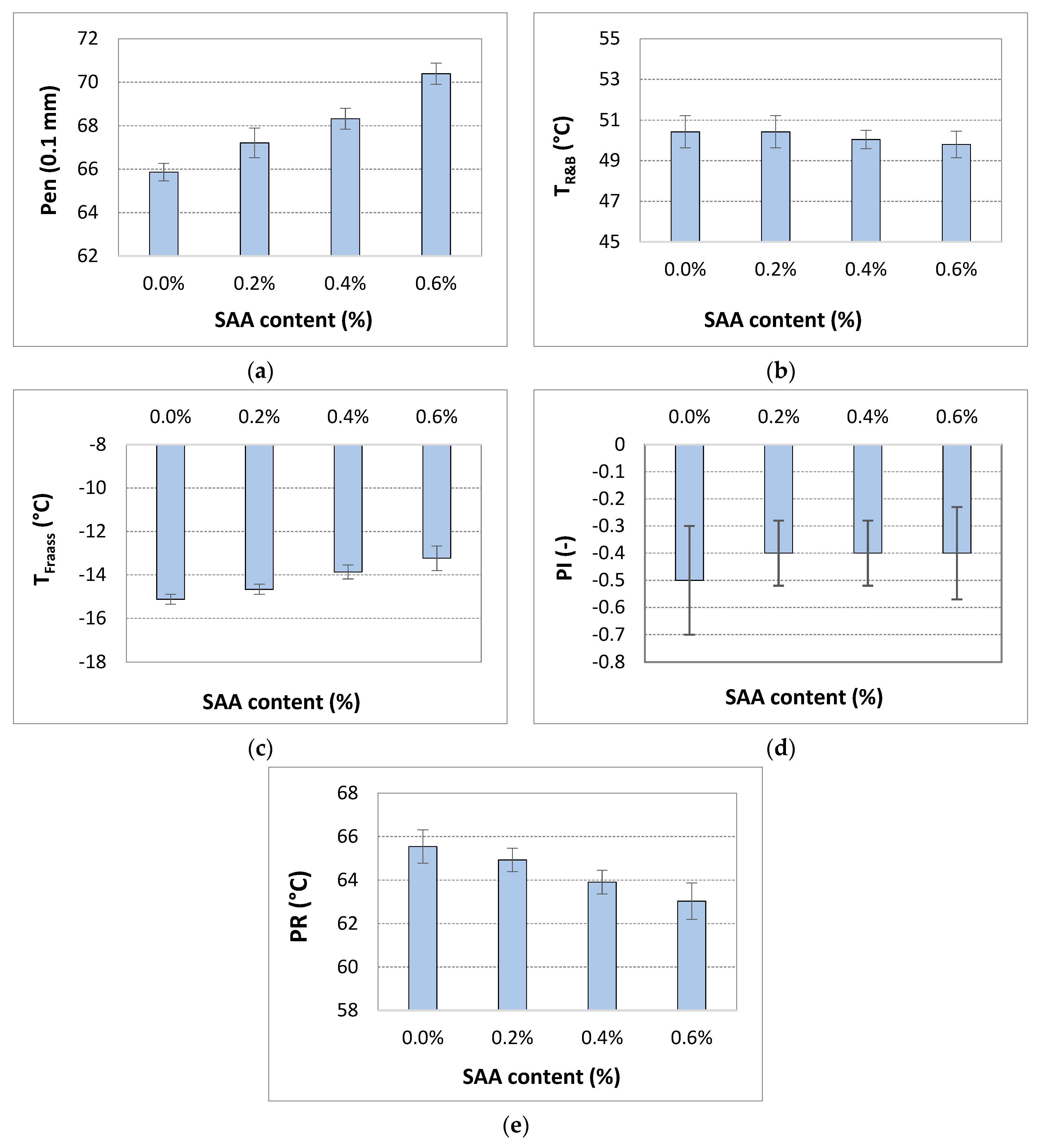
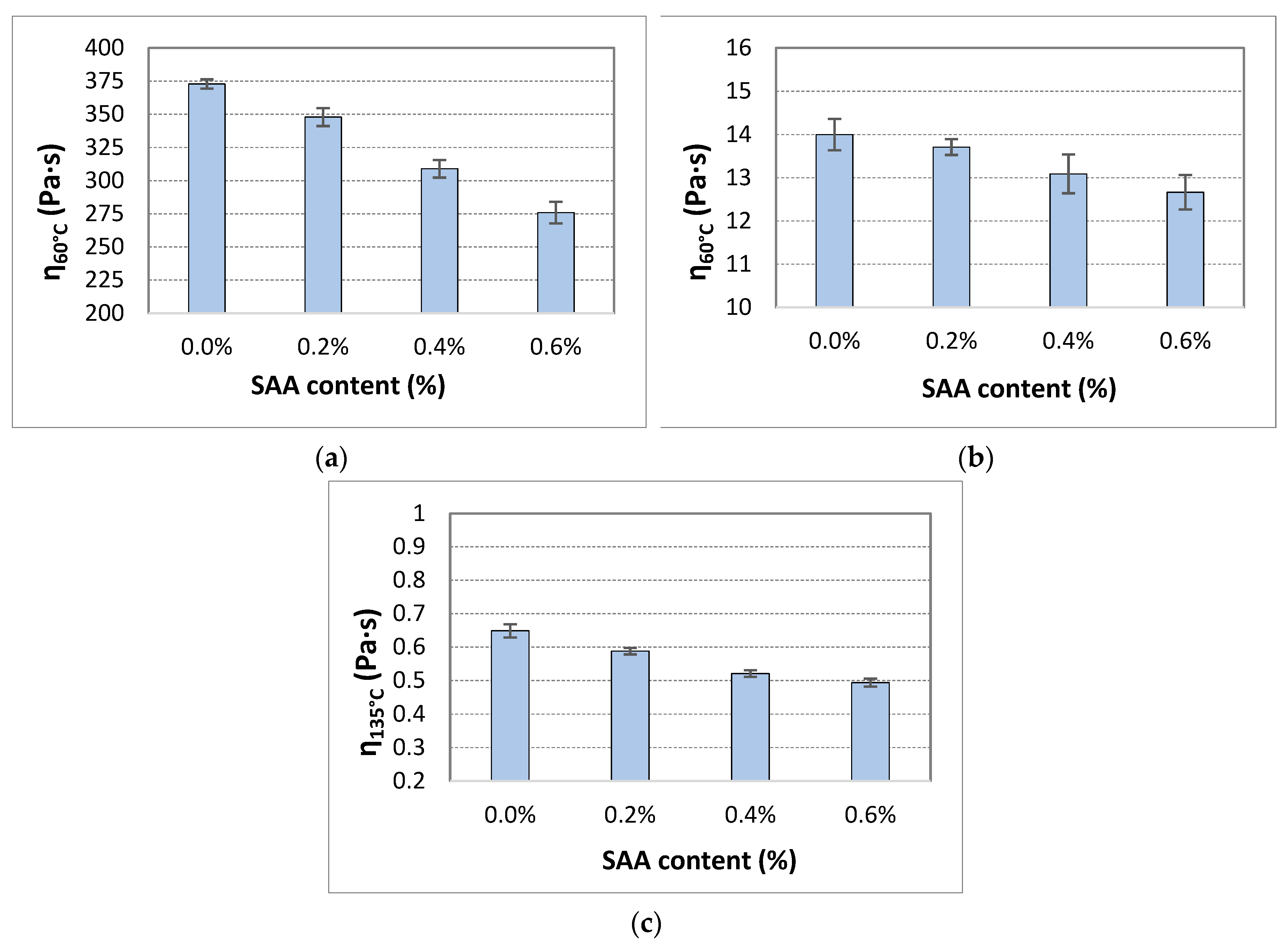

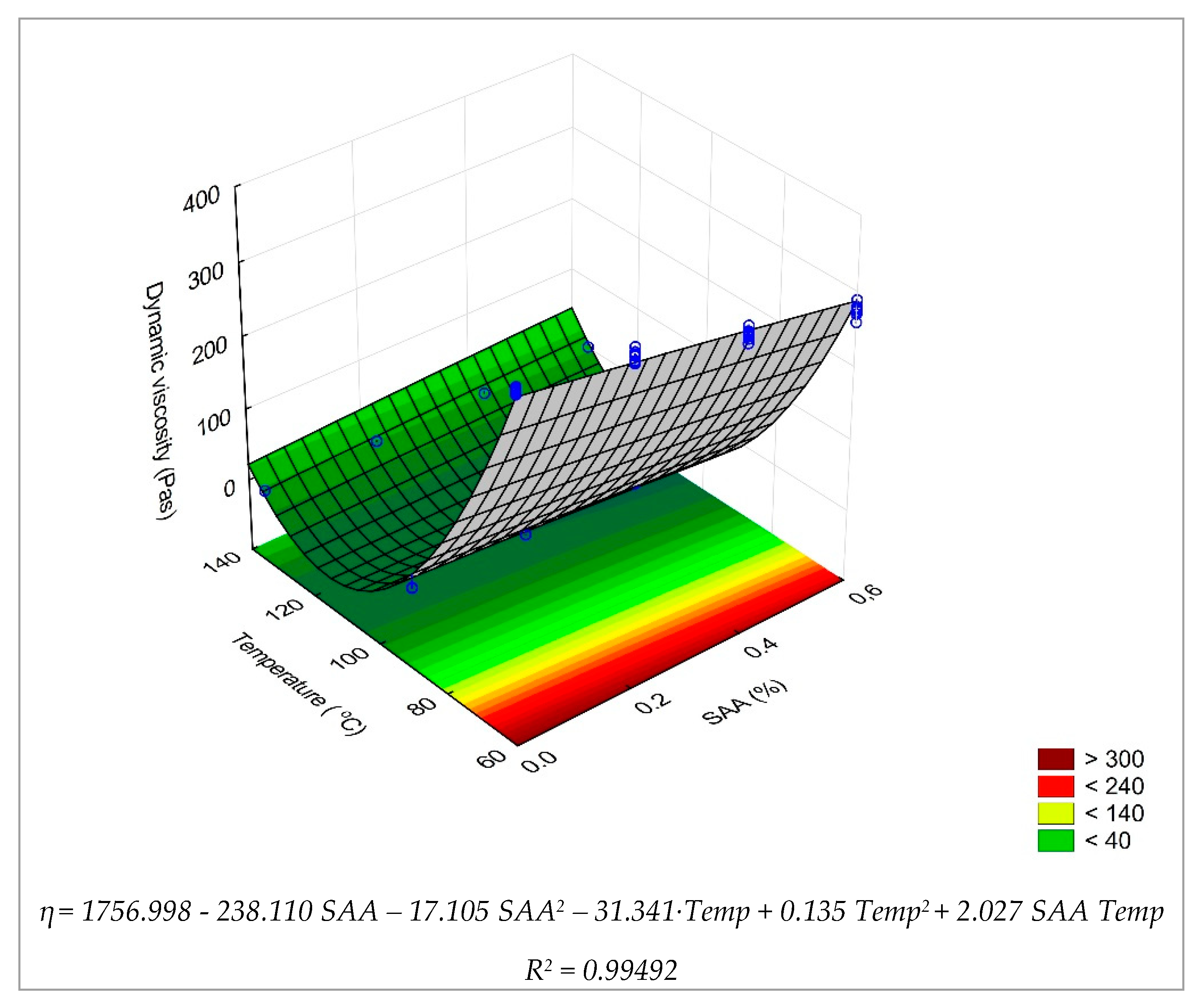
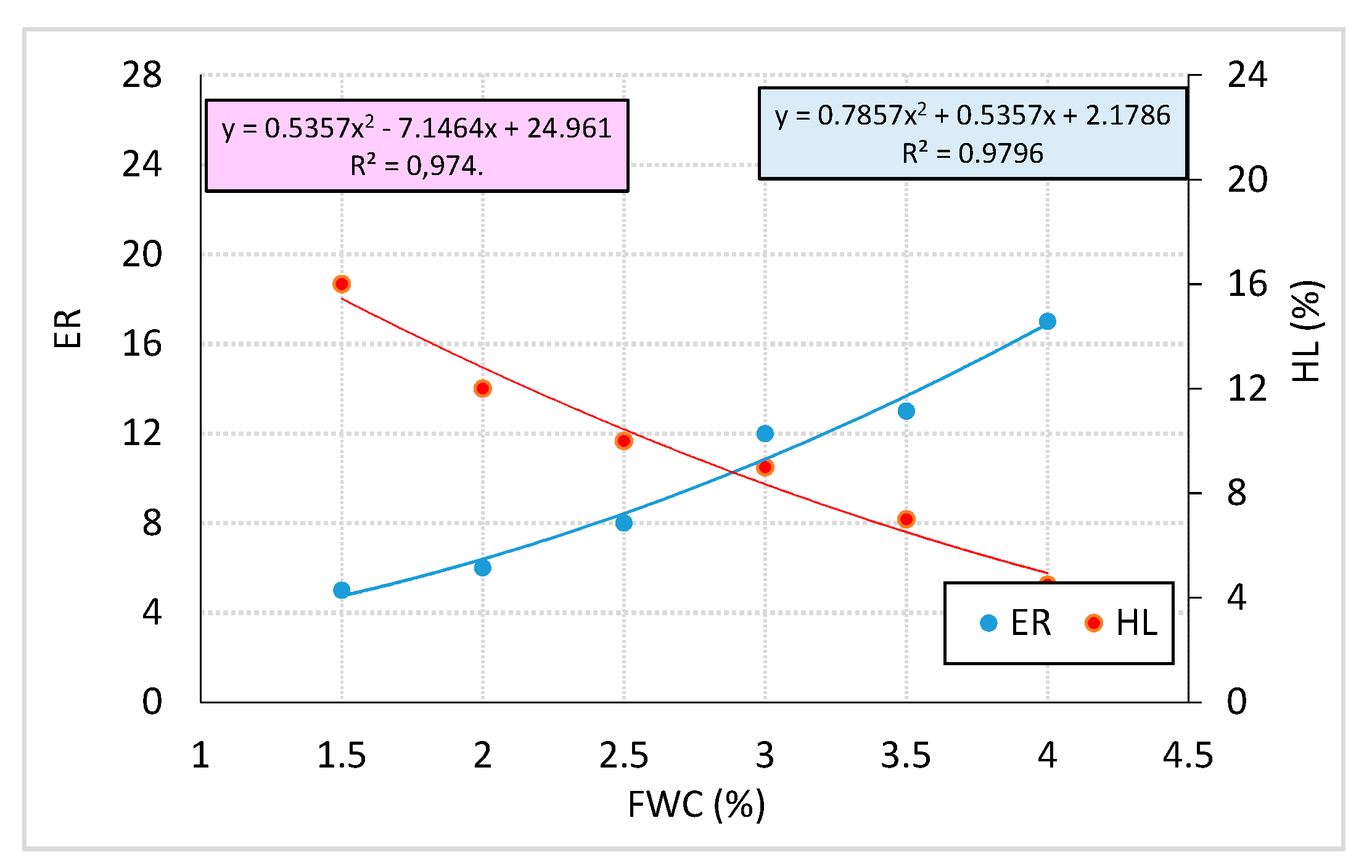
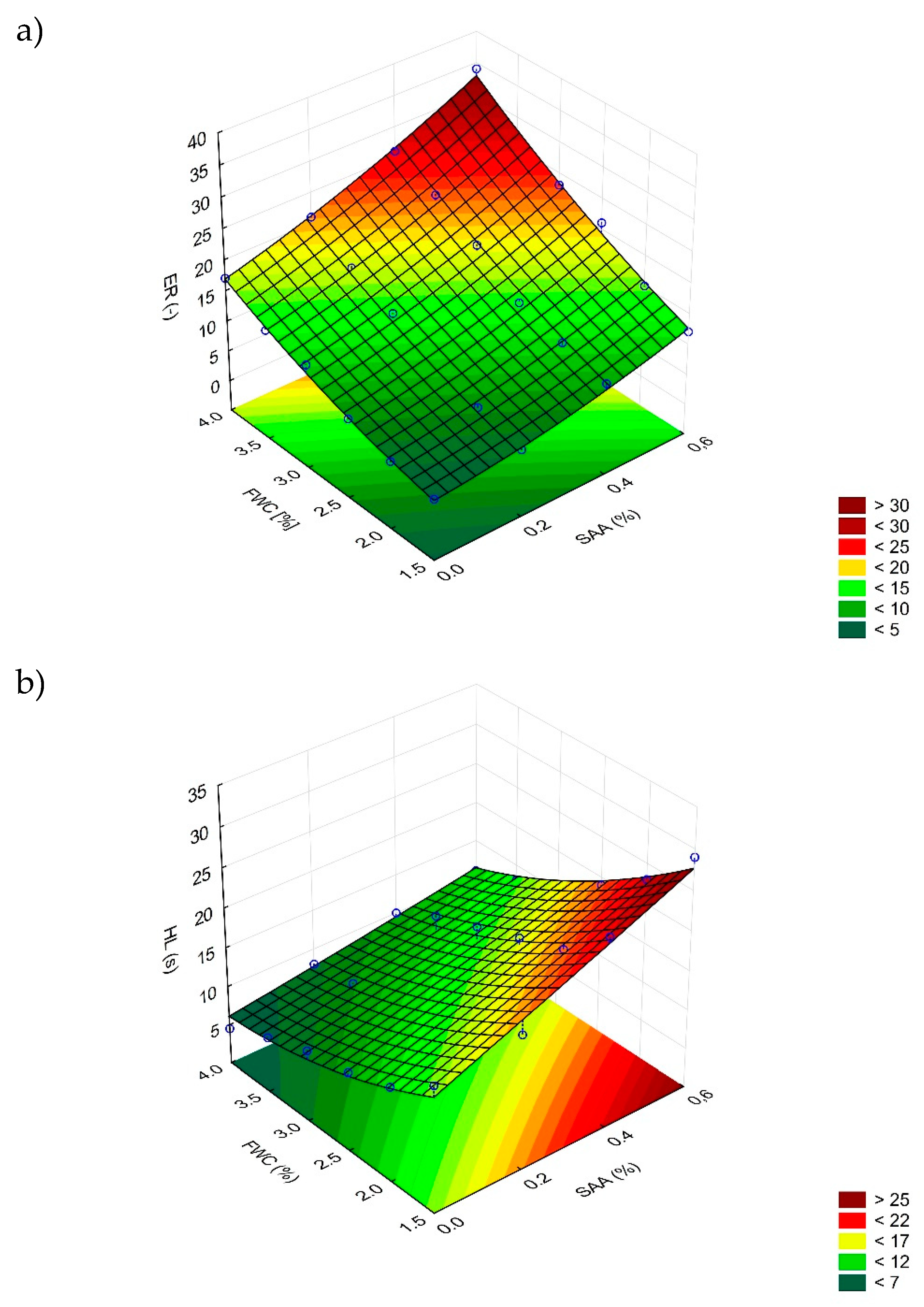
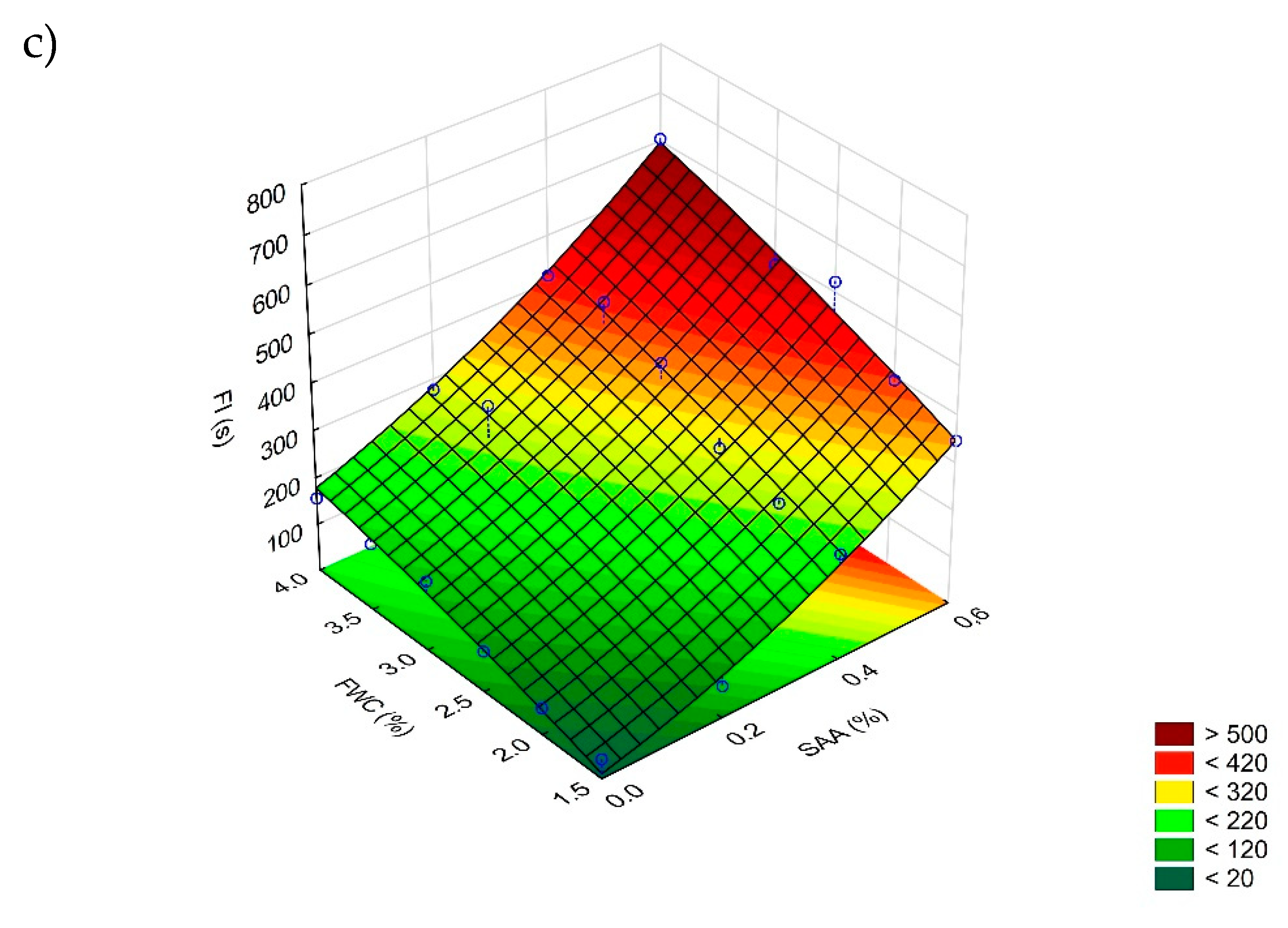
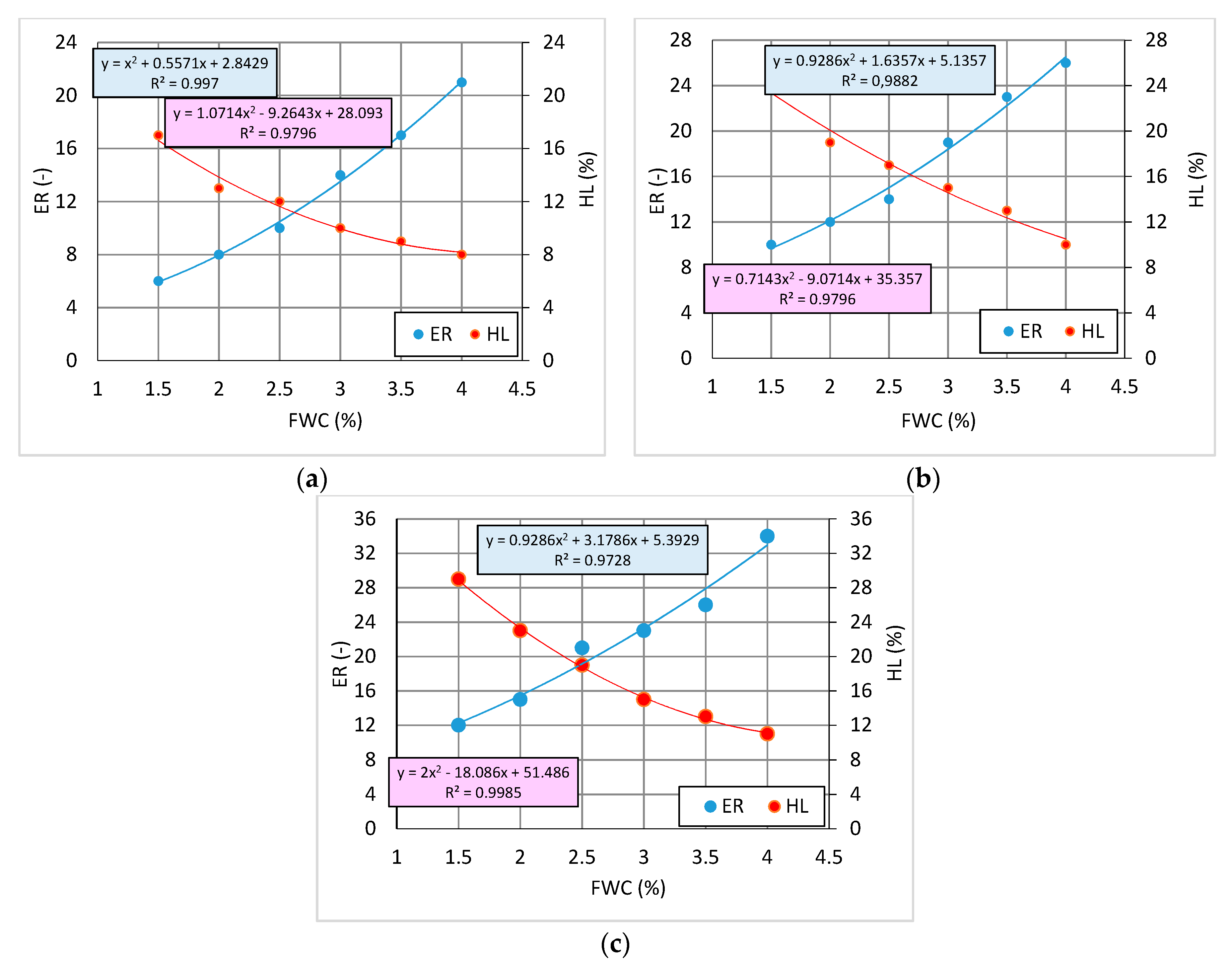
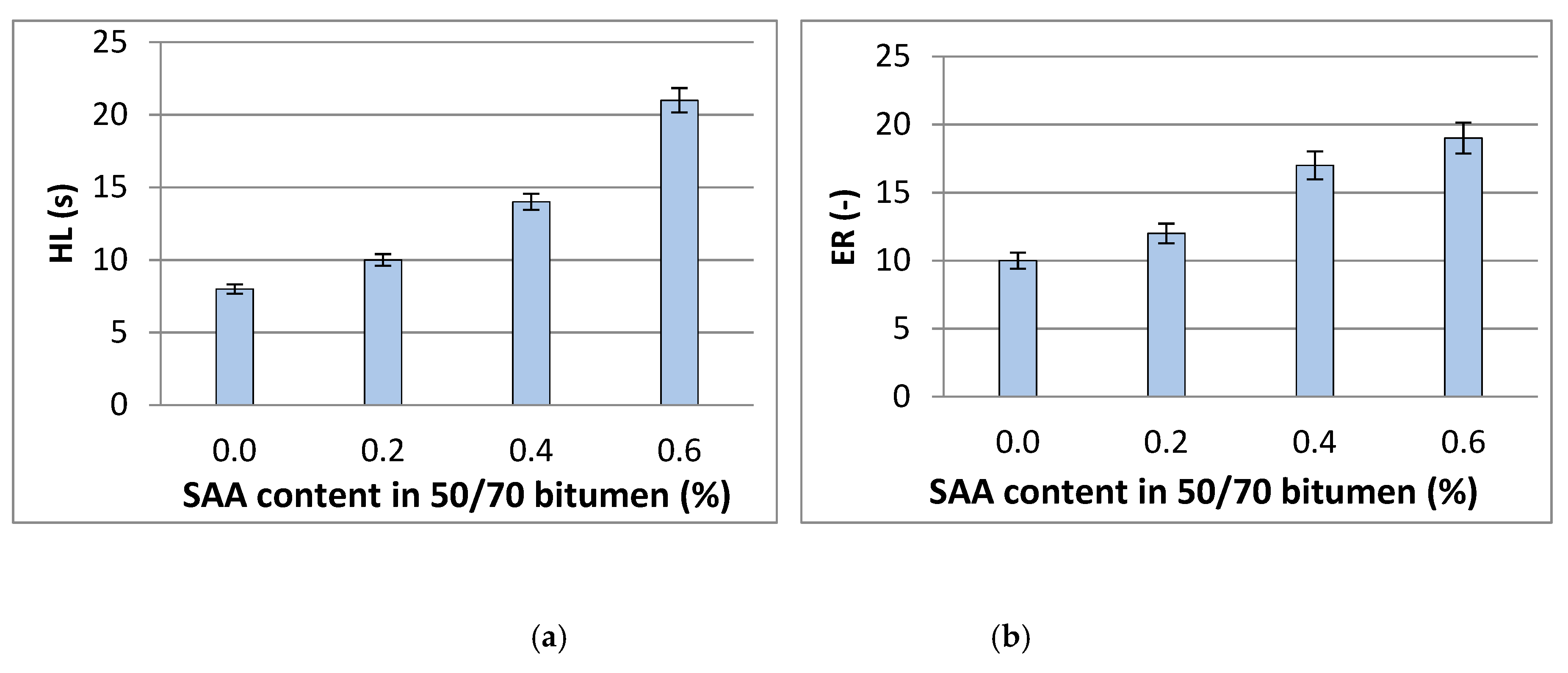
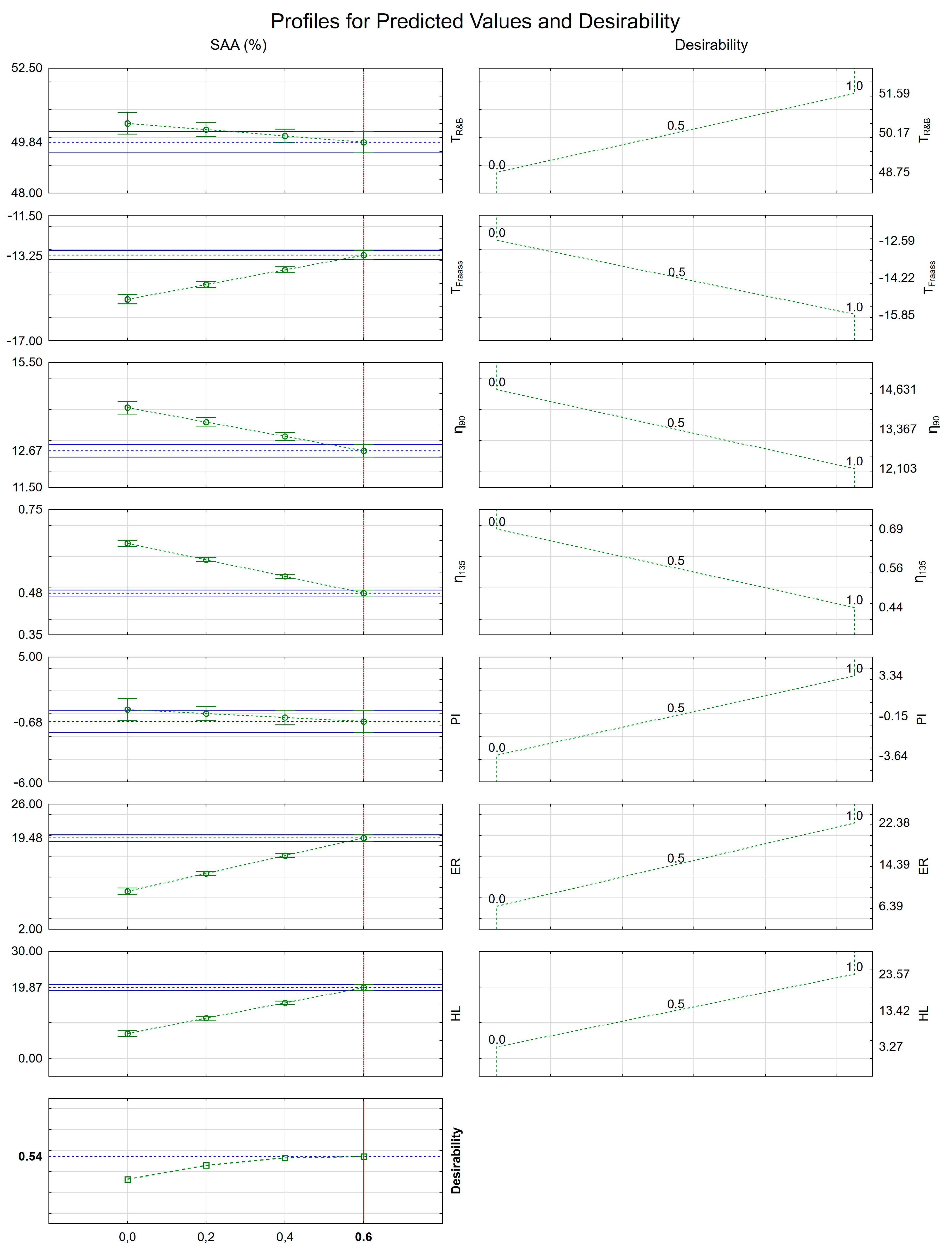
| Property | Test Method | Unit of Measure | Result |
|---|---|---|---|
| Penetration at 25 °C | EN 1426 | 0.1 mm | 65.9 |
| Softening point TR&B | EN 1427 | °C | 50.4 |
| Fraass breaking point | EN 12593 | °C | −15.1 |
| Dynamic viscosity at: 60 °C 90 °C 135 °C | EN 12702-2 | Pa∙s | 372.9 14.0 0.649 |
| Property | Unit of Measure | Value |
|---|---|---|
| Appearance | - | Brown viscous liquid |
| Density at 20 °C | Mg/m3 | 0.98 |
| Pour point | °C | <0 |
| Viscosity at 20 °C | mP | 3000 |
| Viscosity at 50 °C | mP | 400 |
| Amine index | mg HCl/g | 159–185 |
| Acid index | mg KOH/g | <10 |
| Freezing point | °C | <0 |
| Flash point (open flame) | °C | >218 |
| Foaming Process Parameters | Value |
|---|---|
| Bitumen temperature | 155 °C |
| Water temperature | 20 °C |
| Water flow rate | 100 g/s |
| Bitumen foaming time | 5 s |
| Air pressure | 500 kPa |
| Water pressure | 600 kPa |
| SAA Content in 50/70 Bitumen (%) | Variable | Value of Statistical Parameters of 50/70 Bitumen Properties | |||||
|---|---|---|---|---|---|---|---|
| Valid N | Max. | Min. | Mean | Std. Dev. | Coef. Var. (%) | ||
| 0.0 | Pen | 9 | 66.1 | 65.4 | 65.9 | 0.40 | 0.6 |
| TR&B | 9 | 51.7 | 49.8 | 50.3 | 0.44 | 0.9 | |
| TFraass | 9 | −15.4 | −14.7 | −15.1 | 0.22 | 1.5 | |
| PI | 9 | −0.6 | −0.4 | −0.5 | 0.20 | 4.6 | |
| PR | 9 | 66.9 | 64.6 | 65.5 | 0.77 | 1.2 | |
| 0.2 | Pen | 9 | 68.8 | 66.1 | 67.2 | 0.68 | 1.0 |
| TR&B | 9 | 50.8 | 49.7 | 50.3 | 0.44 | 0.9 | |
| TFraass | 9 | −15.0 | −14.4 | −14.7 | 0.23 | 1.6 | |
| PI | 9 | −0.6 | −0.3 | −0.4 | 0.12 | 2.0 | |
| PR | 9 | 65.7 | 64.2 | 64.9 | 0.53 | 0.8 | |
| 0.4 | Pen | 9 | 68.9 | 67.7 | 68.3 | 0.48 | 0.7 |
| TR&B | 9 | 50.7 | 49.2 | 50.0 | 0.45 | 0.9 | |
| TFraass | 9 | −14.3 | −13.7 | −13.9 | 0.32 | 2.3 | |
| PI | 9 | −0.5 | −0.4 | −0.4 | 0.12 | 2.8 | |
| PR | 9 | 64.6 | 63.2 | 63.9 | 0.54 | 0.8 | |
| 0.6 | Pen | 9 | 70.9 | 69.6 | 70.4 | 0.54 | 0.8 |
| TR&B | 9 | 50.9 | 49.0 | 49.8 | 0.65 | 1.3 | |
| TFraass | 9 | −13.7 | −12.3 | −13.2 | 0.57 | 4.3 | |
| PI | 9 | −0.5 | −0.4 | −0.4 | 0.17 | 4.2 | |
| PR | 9 | 64.6 | 62.0 | 63.0 | 0.84 | 1.3 | |
| Response | SS | MS | F | p-Value |
|---|---|---|---|---|
| Pen | 98.8 | 32.9 | 119.8 | <0.001 |
| TR&B | 2.52 | 0.84 | 1.8 | 0.171 |
| TFraass | 19.007 | 6.336 | 48.09 | <0.001 |
| SAA Content in 50/70 Bitumen (%) | Dynamic Viscosity (Pa·s) | |||||
|---|---|---|---|---|---|---|
| Valid N | Max. | Min. | Mean | Std. Dev. | Coef. Var. (%) | |
| 60 °C | ||||||
| 0.0 | 9 | 375.9 | 366.8 | 372.9 | 3.42 | 0.92 |
| 0.2 | 9 | 359.8 | 338.5 | 347.9 | 6.72 | 1.93 |
| 0.4 | 9 | 321.1 | 303.3 | 309.0 | 6.63 | 2.14 |
| 0.6 | 9 | 288.9 | 259.0 | 275.8 | 8.10 | 2.93 |
| 90 °C | ||||||
| 0.0 | 9 | 14.5 | 13.6 | 14.0 | 0.36 | 2.57 |
| 0.2 | 9 | 14.0 | 13.4 | 13.7 | 0.18 | 1.33 |
| 0.4 | 9 | 13.8 | 12.3 | 13.1 | 0.44 | 3.42 |
| 0.6 | 9 | 13.4 | 12.1 | 12.7 | 0.40 | 3.15 |
| 135 °C | ||||||
| 0.0 | 9 | 0.667 | 0.611 | 0.649 | 0.02 | 3.05 |
| 0.2 | 9 | 0.603 | 0.579 | 0.588 | 0.01 | 1.65 |
| 0.4 | 9 | 0.531 | 0.509 | 0.521 | 0.01 | 1.86 |
| 0.6 | 9 | 0.509 | 0.479 | 0.494 | 0.01 | 2.40 |
| Variable | SS | MS | F | p-Value |
|---|---|---|---|---|
| η60 | 49321 | 16440 | 394.50 | <0.001 |
| η90 | 9.782 | 3.261 | 24.86 | <0.001 |
| η135 | 0.18337 | 0.06112 | 239.47 | <0.001 |
| Effect | Variable: η (Pa·s); R2 = 0.99492; R2 − adj = 0.99467; Pure Error MS = 13.93529 | |||
|---|---|---|---|---|
| SS | MS | F | p-Value | |
| (1)SAA (%)(L) | 13838 | 13838 | 993.0 | <0.001 |
| SAA (%)(Q) | 51 | 51 | 3.6 | 0.059 |
| (2)Temp (°C)(L) | 1910862 | 1910862 | 137124.0 | <0.001 |
| Temp (°C)(Q) | 790462 | 790462 | 56723.8 | <0.001 |
| 1L* 2L | 21067 | 21067 | 1511.8 | <0.001 |
| Lack of fit | 11366 | 1894 | 135.9 | <0.001 |
| Pure error | 1338 | 14 | - | - |
| Total SS | 2502298 | - | - | - |
| Effect | Statistical Parameters | |||||
|---|---|---|---|---|---|---|
| Regression Coeff. | SE | t | p-Value | −95,% Cof. Lmt | +95,% Cnf. Lmt | |
| Intercept | 1756.998 | 5.364843 | 327.502 | <0.001 | 1746.349 | 1767.647 |
| SAA (%) | −238.110 | 7.491880 | −31.782 | <0.001 | −252.981 | −223.238 |
| SAA2 (%) | −17.105 | 8.980203 | −1.905 | 0.060 | −34.931 | 0.720 |
| Temp (°C) | −31.341 | 0.113826 | −275.337 | <0.001 | −31.566 | −31.115 |
| Temp2 (°C) | 0.135 | 0.000568 | 238.168 | <0.001 | 0.134 | 0.136 |
| SAA (%) * Temp (°C) | 2.027 | 0.052119 | 38.882 | <0.001 | 1.923 | 2.130 |
| Effect | Variable: ER (-); R2 = 0.9875; Adj.: 0.98406; Residual MS = 0.8758664 | ||||
| SS | df | MS | F | p-Value | |
| (1)FWC (%)(L) | 736.129 | 1 | 736.1286 | 840.4576 | <0.001 |
| FWC (%)(Q) | 7.741 | 1 | 7.7411 | 8.8382 | 0.008 |
| (2)SAA (%)(L) | 472.033 | 1 | 472.0333 | 538.9330 | <0.001 |
| SAA(%)(Q) | 6.000 | 1 | 6.0000 | 6.8504 | 0.017 |
| 1L * 2L | 26.331 | 1 | 26.3314 | 30.0633 | <0.001 |
| Error | 15.766 | 18 | 0.8759 | - | - |
| Total SS | 1264.000 | 23 | - | - | - |
| Effect | Variable: HL (s); R2= 0.9624; Adj.: 0.95197; Residual MS = 1.61479 | ||||
| SS | df | MS | F | p-value | |
| (1)SAA (%)(L) | 280.6021 | 1 | 280.6021 | 173.7700 | <0.001 |
| SAA (%)(Q) | 0.0938 | 1 | 0.0938 | 0.0581 | 0.812 |
| (2)FWC (%)(L) | 428.7937 | 1 | 428.7937 | 265.5415 | <0.001 |
| FWC (%)(Q) | 10.8936 | 1 | 10.8936 | 6.7461 | 0.018 |
| 1L * 2L | 23.7902 | 1 | 23.7902 | 14.7327 | 0.001 |
| Error | 29.0662 | 18 | 1.6148 | - | - |
| Total SS | 773.2396 | 23 | - | - | - |
| Effect | Variable: FI (s); R2 = 0.96337; Adj: 0.95319; Residual MS = 1282.081 | ||||
| SS | df | MS | F | p-Value | |
| (1)SAA(%)(L) | 474720.1 | 1 | 474720.1 | 370.2732 | <0.001 |
| SAA(%)(Q) | 6684.3 | 1 | 6684.3 | 5.2137 | 0.035 |
| (2)FWC (%)(L) | 122235.3 | 1 | 122235.3 | 95.3414 | <0.001 |
| FWC (%)(Q) | 596.7 | 1 | 596.7 | 0.4654 | 0.504 |
| 1L * 2L | 2655.3 | 1 | 2655.3 | 2.0711 | 0.168 |
| Error | 23077.5 | 18 | 1282.1 | - | - |
| Total SS | 629969.2 | 23 | - | - | - |
| Response | Effect | Parameter | SE | t(18) | p-Value | −95,% Cnf. Lmt | +95,% Cnf. Lmt |
|---|---|---|---|---|---|---|---|
| ER R2 = 0.9873 | Intercept | 2.963 | 2.362 | 1.254 | 0.225 | −1.999 | 7.926 |
| (1)SAA [%](L) | −2.752 | 4.063 | −0.677 | 0.506 | −11.289 | 5.784 | |
| SAA [%](Q) | 12.500 | 4.776 | 2.617 | 0.017 | 2.466 | 22.534 | |
| (2)FWC [%](L) | −0.169 | 1.726 | −0.099 | 0.923 | −3.795 | 3.457 | |
| FAC [%](Q) | 0.911 | 0.307 | 2.973 | 0.008 | 0.267 | 1.554 | |
| 1L * 2L | 5.486 | 1.001 | 5.483 | 0.001 | 3.384 | 7.588 | |
| HL R2 = 0.9742 | Intercept | 26.148 | 3.208 | 8.151 | <0.001 | 19.408 | 32.886 |
| (1)SAA [%](L) | 28.693 | 5.518 | 5.201 | <0.001 | 17.102 | 40.284 | |
| SAA [%](Q) | 1.563 | 6.484 | 0.241 | 0.812 | −12.061 | 15.186 | |
| (2)FWC [%](L) | −9.328 | 2.344 | −3.980 | <0.001 | −14.251 | −4.404 | |
| FWC [%](Q) | 1.080 | 0.416 | 2.597 | 0.018 | 0.207 | 1.954 | |
| 1L * 2L | −5.214 | 1.358 | −3.838 | <0.001 | −8.068 | −2.360 | |
| FI R2 = 0.9637 | Intercept | −137.999 | 90.380 | −1.527 | 0.144 | −327.881 | 51.882 |
| (1)SAA [%](L) | 227.147 | 155.463 | 1.461 | 0.161 | −99.469 | 553.762 | |
| SAA [%](Q) | 417.219 | 182.723 | 2.283 | 0.034 | 33.333 | 801.104 | |
| (2)FWC [%](L) | 111.026 | 66.033 | 1.681 | 0.109 | −27.706 | 249.758 | |
| FWC [%](Q) | −7.996 | 11.720 | −0.682 | 0.503 | −32.619 | 16.628 | |
| 1L * 2L | 55.087 | 38.278 | 1.439 | 0.167 | −25.333 | 135.507 |
| Binder type | Foaming Parameters | ||
|---|---|---|---|
| ER (-) | HL (s) | FWC (%) | |
| 50/70 | 10 | 8 | 2.5 |
| 50/70 + 0.2% SAA | 12 | 10 | 2.5 |
| 50/70 + 0.4% SAA | 17 | 14 | 2.5 |
| 50/70 + 0.6% SAA | 19 | 21 | 2.5 |
| Variable | SS for The Full Model with Respect to The SS for Residuals | ||||||||||
|---|---|---|---|---|---|---|---|---|---|---|---|
| R | R2 | Adj.-R2 | SS Model | DF Model | MS Model | SS Resid. | Df Resid. | MS Resid. | F | p-Value | |
| TR&B | 0.3688 | 0.1360 | 0.0836 | 2.40 | 2 | 1.20 | 15.250 | 33 | 0.462 | 2.598 | 0.090 |
| TFraass | 0.9018 | 0.8134 | 0.8020 | 18.88 | 2 | 9.44 | 4.333 | 33 | 0.131 | 71.927 | <0.001 |
| η90 | 0.8310 | 0.6905 | 0.6718 | 9.65 | 2 | 4.82 | 4.325 | 33 | 0.131 | 36.824 | <0.001 |
| η135 | 0.9750 | 0.9507 | 0.9477 | 0.1299 | 2 | 0.06 | 0.006 | 33 | 0.000 | 318.55 | <0.001 |
| PI | 0.2863 | 0.0819 | 0.0263 | 8.73 | 2 | 4.36 | 97.850 | 33 | 2.965 | 1.473 | 0.243 |
| ER | 0.9654 | 0.9321 | 0.9280 | 520.64 | 2 | 260.32 | 37.911 | 33 | 1.148 | 226.59 | <0.001 |
| HL | 0.9903 | 0.9807 | 0.9795 | 883.41 | 2 | 441.70 | 17.338 | 33 | 0.525 | 840.67 | <0.001 |
© 2019 by the authors. Licensee MDPI, Basel, Switzerland. This article is an open access article distributed under the terms and conditions of the Creative Commons Attribution (CC BY) license (http://creativecommons.org/licenses/by/4.0/).
Share and Cite
Iwański, M.M.; Chomicz-Kowalska, A.; Maciejewski, K. Effect of Surface Active Agent (SAA) on 50/70 Bitumen Foaming Characteristics. Materials 2019, 12, 3514. https://doi.org/10.3390/ma12213514
Iwański MM, Chomicz-Kowalska A, Maciejewski K. Effect of Surface Active Agent (SAA) on 50/70 Bitumen Foaming Characteristics. Materials. 2019; 12(21):3514. https://doi.org/10.3390/ma12213514
Chicago/Turabian StyleIwański, Mateusz M., Anna Chomicz-Kowalska, and Krzysztof Maciejewski. 2019. "Effect of Surface Active Agent (SAA) on 50/70 Bitumen Foaming Characteristics" Materials 12, no. 21: 3514. https://doi.org/10.3390/ma12213514
APA StyleIwański, M. M., Chomicz-Kowalska, A., & Maciejewski, K. (2019). Effect of Surface Active Agent (SAA) on 50/70 Bitumen Foaming Characteristics. Materials, 12(21), 3514. https://doi.org/10.3390/ma12213514







